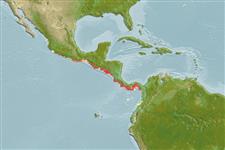>
Tetraodontiformes (Puffers and filefishes) >
Tetraodontidae (Puffers) > Tetraodontinae
Etymology: Sphoeroides: Greek, sphaira = ball + Greek, suffix, oides = similar to (Ref. 45335).
Eponymy: Dr Richard Heinrich ‘Dick’ Rosenblatt (1930–2014) was an American ichthyologist and oceanographer. [...] (Ref. 128868), visit book page.
Environment: milieu / climate zone / depth range / distribution range
Ecologia
marino; salmastro demersale; distribuzione batimetrica 4 - 17 m (Ref. 13103). Tropical
Eastern Central Pacific: Costa Rica and Panama.
Size / Peso / Age
Maturity: Lm ? range ? - ? cm
Max length : 21.9 cm SL maschio/sesso non determinato; (Ref. 13103)
Inhabit inshore waters to 4 m depth in brackish-water estuaries, amongst mangroves and river mouths.
Life cycle and mating behavior
Maturità | Riproduzione | Deposizione | Uova | Fecundity | Larve
Walker, H.J. Jr. and W.A. Bussing, 1996. Two new pufferfishes fo the genus Sphoeroides from the Eastern Pacific. Copeia 1996(3):677-684. (Ref. 13103)
IUCN Red List Status (Ref. 130435: Version 2024-1)
Threat to humans
Harmless
Human uses
Pesca: commerciale
Strumenti
Special reports
Download XML
Fonti Internet
Estimates based on models
Preferred temperature (Ref.
123201): 27.9 - 29.1, mean 28.5 °C (based on 103 cells).
Phylogenetic diversity index (Ref.
82804): PD
50 = 0.5000 [Uniqueness, from 0.5 = low to 2.0 = high].
Bayesian length-weight: a=0.01622 (0.00726 - 0.03621), b=2.92 (2.74 - 3.10), in cm total length, based on LWR estimates for this (Sub)family-body shape (Ref.
93245).
Trophic level (Ref.
69278): 3.2 ±0.47 se; based on food items.
Resilienza (Ref.
120179): Alto, tempo minimo di raddoppiamento della popolazione meno di 15 mesi (Preliminary K or Fecundity.).
Fishing Vulnerability (Ref.
59153): Low vulnerability (17 of 100).
